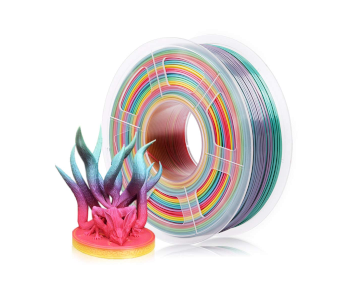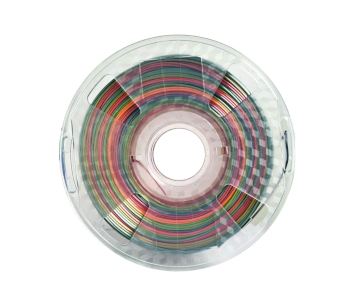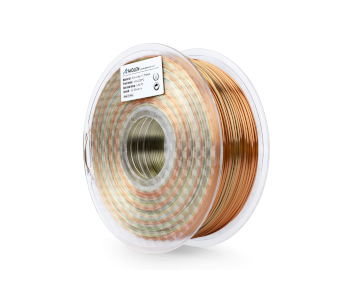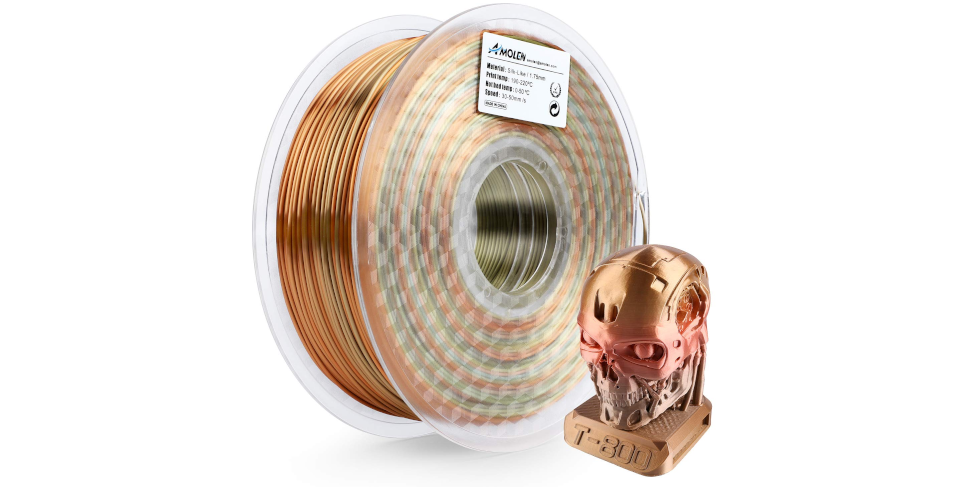What is Rainbow Gradient Filament? Properties and Best Brands
You probably have a favorite filament color that you always keep in stock for when you want to work on projects for fun. However, printing in a single color can get really old after a while, even if it is in your favorite color. In most cases, printing in multiple colors is only possible if you have a 3D printer with a multi-extrusion system.
What if there was a way to print in more than one color with just a single extruder? In fact, it’s possible to print with a whole gradient of colors – not just one or two. If you’ve never tried printing with a rainbow gradient filament before, then let us tell you all about this amazingly fun filament.
What is rainbow gradient filament?
Simply put, a rainbow gradient filament has multiple colors that transition across the different colors of a rainbow. How quickly each color transitions to the next depends on the specific filament brand – this can range from a transition every three to five meters. This has a direct effect on how thick the “bands” of color are in the finished product.
In practically all rainbow gradient filaments we’ve seen, PLA was used as the base plastic matrix. This is probably a deliberate choice to make these rainbow gradient filaments as user-friendly as possible. This is the type of filament your use on “fun” projects, and they have proven to very popular amongst 3D printing beginners and kids.
The choice of PLA as a base plastic means that prints made with rainbow gradient filament probably won’t have a lot of functional value. They may also only have limited value for professional work, for reasons that we shall see later. If you just want to print nice display items for your house or office, then projects made with rainbow gradient filament likely won’t fail to impress.
Properties of rainbow gradient filament
As with every single filament used for 3D printing, rainbow gradient filament has benefits as well as drawbacks. To help you manage your expectations, these are the properties of rainbow gradient filament – both good and bad.
1. Visually impressive
It’s tough not to get tempted to buy a spool of rainbow gradient filament once you see how its finished products look like. They come out with this gorgeous spectrum of colors, with each color transitioning smoothly to the next. There’s really nothing quite like rainbow gradient filament in terms of aesthetics and buying it just for the looks is a perfectly justifiable decision.
2. Unpredictable color profile
The thing about a rainbow gradient filament is that its different colors transition from one to the other at segments with set length values. While it’s possible to control how the gradient will look like on the final product by adjusting the layer thickness and infill settings, it’s virtually impossible predict exactly how the finished print will look like. Even the starting color is out of your control, unless you’re fine with clipping some of the filament and not using particular segments.
This unpredictability could be problematic if you’re offering 3D printing as a service. Using a rainbow gradient filament means that you cannot guarantee how a finished print will look like, even when you use the same printer settings. It’s not a deal-breaker but it is important enough that you’ll need to disclose it to potential customers.
3. Easy to print with
Since rainbow gradient filament is simply a variation of colored PLA, it comes with both the ease of use and budget-friendly price of standard PLA. This is in contrast to specialty or composite filaments that use PLA as the plastic matrix but can be up to four or five times more expensive.
The fact that rainbow gradient filament is just as easy to use as standard PLA is a huge boost to its accessibility and overall appeal. This isn’t the type of filament that looks cool but is gated behind some higher level of 3D printing skill or special accessories.
4. Looks great after some finishing
Any filament looks great after finishing, but this statement is particularly true for prints made from rainbow gradient filament. Getting rid of the layer lines makes the transition between colors look smooth enough to be indistinguishable. The transition, coupled with the smooth external finish that you can achieve with sanding and polishing, should make for a visually stunning multi-colored print.
If you’re looking to 3D print a customized gift, then there are few filament materials that can rival the aesthetics of rainbow gradient filament.
Just the mere fact that rainbow gradient filament isn’t expensive and will almost always look stunning should be enough reasons for a 3D printing enthusiast to give it a shot. Even having this filament on stock sounds like a great idea, just in case you forgot someone’s birthday and need to create a gift on the spot.
Best brands of rainbow gradient filament
If you’re looking to try a rainbow gradient filament, the good news is that the filament is popular enough to warrant brands to create a decent selection of variants of the filament. The following list features some of the best and most diverse options:
1. SUNLU Rainbow PLA Filament

This rainbow PLA filament from SUNLU is a good option if you’re looking for something that’s a bit more basic and stays true to the essence of a rainbow gradient of colors. This filament runs across the whole gamut of rainbow colors with loud hues, with no inkling of restraint whatsoever. If you want finished prints that have as vibrant colors as possible, then this filament should be your top choice.
The SUNLU rainbow filament is a basic PLA filament with no additives aside from the colored pigments. This means that you won’t need to use special accessories, nor can you expect any problems with warping or fumes. Prints made from this filament will come out with a matte-like finish, which you can simply sand and polish if you want to achieve a smoother appearance.
SUNLU doesn’t specify how long the segments of filament are before they transition from one color to another, so you may just have to make your own measurements. Without this piece of information, you may have to do a few trial prints before you can dial in the settings for your desired level of color transition. This is kind of bad news considering that this filament spool is nearly twice as expensive as a standard PLA filament.
2. SHENGTIAN Silk Rainbow PLA Filament

This Silk Rainbow filament kicks things up a notch by infusing a standard rainbow PLA filament with silk strands. The result is a filament that can create prints with vibrant colors and a characteristic luster. The luster is almost metal-like and looks good even without finishing.
A silk filament is a good middle ground option if you want to create prints with a metal-like luster but don’t want to deal with the complications of printing with a metal-infused composite filament. Just keep in mind that the silk strands can still cause some jamming in your nozzle, so it’s best to enable retraction and to use a nozzle with a wide opening. The silk strands aren’t abrasive, though, so you won’t necessarily need to have an all-metal nozzle.
According to SHENGTIAN, the transition between colors can range from five to eight meters. This is a pretty wide range, so predicting how a finished print will look like is probably almost impossible. Prints made with this filament look great, regardless, but you’ll just have to settle for the fact that how they will look like is going to be out of your hands.
3. AMOLEN Multicolor Silk Metal Rainbow Filament

The Silk Metal Rainbow filament from AMOLEN is a more subdued take on the concept of a rainbow gradient filament. By focusing more on the metallic sheen of the filament, AMOLEN is able to come up with a filament that only gives the hint of a rainbow gradient color scheme. If the two previous entries look a bit too loud for you, then this more muted version might be more up your alley.
The color change of this filament seems to be set up at large intervals, so they don’t seem as pronounced if you’re only printing small projects. The benefit of this design is that you also avoid abrupt transitions, resulting in an overall smoother appearance. In terms of consistency, quality, and strength, this filament is top-notch. The metallic sheen looks great even without finishing.
As with the previous entry, be wary of issues with jammed nozzles whenever your print with a composite filament. A wider mouthed nozzle (0.4 mm. or larger) would be preferable.
Final thoughts
One of the best things about FDM printing is the sheer variety of filament types on offer. From standard plastic to composite filaments, there’s a seemingly unending array of different filaments that any 3D printing enthusiast can try.
A rainbow gradient filament is nowhere as complex as metallic or high-temperature filaments. It’s a pretty simple filament that looks great. It’s also relatively cheap. The biggest drawback is that you can’t exactly predict how a finished print will look like, but a little surprise here and there isn’t a bad thing.


